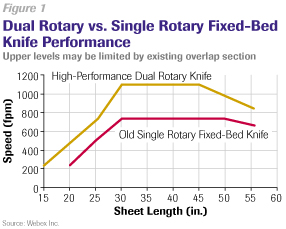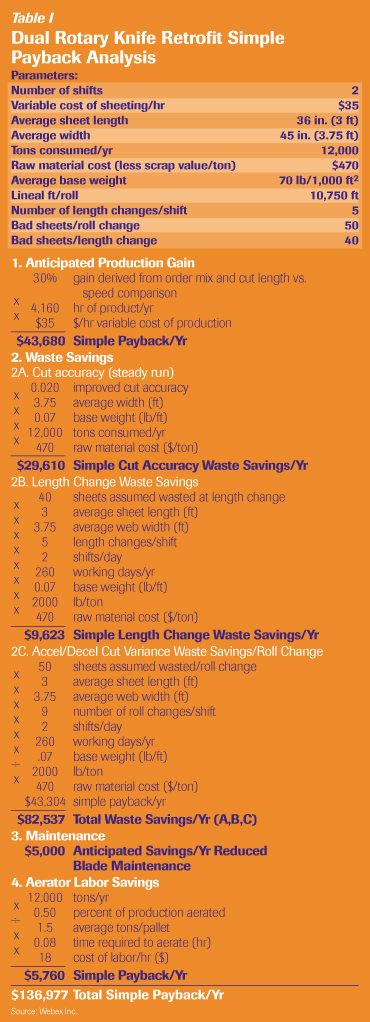Retrofitting Older Sheeters
- Published: July 01, 2003, By Mark Abderholden, Webex Inc.
A dual rotary knife retrofit on an older sheeter can improve equipment productivity and reduce waste effectively.
As more and more converting and folding carton plants seek ways to improve their sheeting operations, many are electing to retrofit existing equipment rather than incur the expense of buying new. Although the cost of a new sheeter often can be justified, recent advances in dual rotary knife design have given plant managers the option to improve sheet quality by installing a dual rotary knife retrofit into their existing sheeter.
A retrofit can produce higher quality sheets, improve productivity, and reduce waste, while providing dramatic cost savings and the potential for payback year after year.
Is a Knife Retrofit Right for You?
Consider two questions:
-
Is the existing sheeter still in good condition?
-
Is your production limited by your current sheeter?
To determine if your sheeter is in good condition, be certain the layboy/piler area remaining after the knife retrofit is mechanically sound. To improve stack quality, upgrades can be made to this area, such as pallet centering/offset piling, tape belt replacement, and the addition of improved side tampers and backstops.
 However, don't spend a great deal of money trying to update a machine that is too old or worn out. Knife retrofit usually can be done on the following sheeter models:
However, don't spend a great deal of money trying to update a machine that is too old or worn out. Knife retrofit usually can be done on the following sheeter models:
- Clark Aiken:
Models K, D, and C. Older models (1930 and 1940) usually are not worth rebuilding
- Moore & White:
Models R75 and R100
- Hamblet:
Models HHD, MHD and SHD
- Lambs Gray:
Most models
Sheeters no longer being manufactured also may be good candidates for a knife retrofit if they are in good mechanical condition.
To determine if your production is limited by your current sheeter, keep in mind there is no one set rule that says a knife retrofit will meet or exceed your production requirements. Each application should be investigated based on specific order mix and material run. However, depending on the sheeter type and configuration, plants typically have experienced a 30-40% increase in production.
Adding a new knife section will increase production without sacrificing quality by allowing faster runs of both long and short sheets, although in some old sheeters the overlap design of the layboy may limit the maximum line speed. Some manufacturers offer high-speed tape belt outfeed upgrades to replace this section, allowing for higher-speed capabilities on the existing sheeter. This also may simplify the physical interface to the existing sheeter during installation.
What Modifications Will Be Needed?
A dual rotary knife retrofit will require minor modifications to the existing sheeter. Positively infinitely variable (P.I.V.) mechanical drives cannot be driven off the main knife motor. A small motor and drive are needed for the lower-speed tape belt sections after the knife. These changes are relatively simple and inexpensive.
 The best possible cut accuracy cannot be achieved without proper web tension control. Either a load cell or swing arm dancer can provide web tension, the latter being preferred because it will compensate for egg-shaped rolls. The addition of good chucks and pneumatic disc brakes on the unwind stand is essential for improving web tension control.
The best possible cut accuracy cannot be achieved without proper web tension control. Either a load cell or swing arm dancer can provide web tension, the latter being preferred because it will compensate for egg-shaped rolls. The addition of good chucks and pneumatic disc brakes on the unwind stand is essential for improving web tension control.
Flat sheets are becoming much more critical with new high-speed, sheet-fed presses. The faster the press, the more sensitive it becomes to curl in the sheet. Additional decurling (multiple stations) should be added directly before the knife if curling is a problem.
The benefits of a dual rotary knife are many:
- Cut Quality
— Dual rotary knives create a cleaner cut that reduces dust and fiber pull.
- Cut Accuracy
— With proper web tension, cut accuracy to ±0.015 in. (0.038 mm) is possible on a dual rotary, direct-drive knife. Cut accuracy is held not only at constant speed but also during acceleration and deceleration of the sheeter. This is not the case for most older fixed-bed (single rotary) knives.
- Short Sheet Runnability
— The minimum and maximum sheeted length for a fixed-bed sheeter is a function of the knife cylinder diameter. Although the maximum practical range is 3 to 1, most manufacturers incorporate at least a 4-to-1 range. If this range is used, significant speed reductions are encountered on the shorter sizes due to the tendency of the single rotary, fixed-bed knife to kick the trailing edge of the sheet. On the longer sizes, the speed is reduced to eliminate excessive dust on the cut edge. Dual rotary direct-drive knives with synchronous cut speed eliminate both problems.
- Performance
— Dual rotary knives are faster and quieter than single rotary, fixed-bed knives (see Figure 1).
- Quick Makeready
— On older sheeters gears have to be changed and P.I.V. pulleys need to be adjusted along with the squareness on all single rotary, fixed-bed knives. This usually takes 5-10 min per makeready and wastes 30-40 sheets in the square adjustment process. On most dual rotary knives that are direct-driven, ready change can take seconds (with virtually no waste), eliminating the need to adjust for squareness.
- Maintenance
— Older single rotary, fixed-bed knives require a great deal of blade maintenance, especially when running high calipers (greater than 0.028 in.) or recycled paperboard. It may be normal to replace the knife blades on a monthly basis, if not more frequently. Blade replacement usually takes 8 hr. Dual rotary knives typically last 9-12 mo or longer before they need replacement.
What About Payback?
A simple payback analysis, with associated parameters, is shown in Table I for a typical converting plant with a single rotary, fixed-bed sheeter.
These parameters for a small to mid-size plant show a financial justification of $136,977/yr for retrofitting a dual rotary knife into an existing sheeter.
In terms of total sheets produced, assuming a sheet length of 36 in., converters can expect to produce 8,000-9,000 sheets/hr after installing a high-performance, dual rotary direct-drive knife onto an existing single rotary, fixed-bed sheeter.
With a dual rotary knife retrofit, there is significant potential to improve productivity, reduce waste, and produce a higher quality end-product. A retrofit on your existing sheeter may be a low-cost option that provides a significant improvement in productivity and quality while reducing waste in your sheeting operation.
Mark Abderholden is the director of sales and marketing at Webex Inc., Neenah, WI, a designer and manufacturer of precision rolls and custom machinery for the web handling and converting industries. Prior experience includes 15 yr with Marquip Inc. in positions including sheeter marketing manager and field service manager. He has a B.S. in mechanical engineering. Abderholden can be reached at 920/729-6666; webex@webexinc.com.
The views and opinions expressed in Technical Reports are those of the author(s), not those of the editors of PFFC. Please address comments to author(s).











